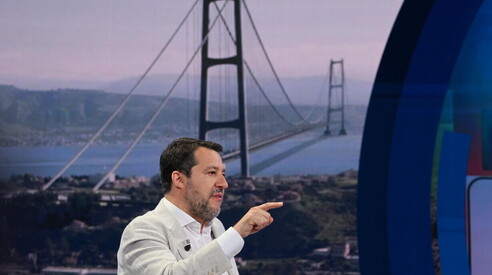How boring, how boring, the hot air on the Messina Bridge (and a gem from Tozzi)


ANSA photo
tired words
Serious opinions are needed, but in the newspapers there is only anti-modern fluff and a parade of clichés that makes you yawn.
On the same topic:
Ultimately, it would be enough to conform to the disconsolate and slightly bored judgment, between two sighs, of Flavia Fratello of "Stampa e regime": "It seems to me that all these comments, absolutely all of them, are the same ones I've already heard, the same ones, even the last time, every time the Messina Bridge is discussed." How boring, how boring. But above all, what a desperate immobility, clinging like the rocks of the Strait to a (pre)judgment already passed . Berlusconi 2002, Renzi and Gentiloni ten years later. Now Salvini. We could let the experts speak, asking whether a single span or three spans is better. Nope, the newspapers, already tired of debating Garlasco, rediscover the "indignation and anger" of "environmental committees, universities, young people" (young people, a new category of experts).
Even leaving aside politicians, Pavlov is their profession: but before talking about the €17 billion stolen from the high-speed rail line (he read about it in Il Sole 24 Ore, but reading Corriere Economia doesn't seem to be quite the case), Conte, the people's accountant, would simply need to calculate how many billions thrown away by his Superbonus could have been better used above the Strait of Messina. And Bonelli, who screams: "It's €14 billion of citizens' money, without a single euro of private investment," is this the same Bonelli who usually tears his hair out when private investors invest in public works, even if it's a football stadium?
The parade of clichés—let's plunder the press for convenience—is yawn-inducing. We risk collapsing under the weight of the "400 academics" of the NO Ponte committee: they let it be known that philosophers and anthropologists are also there, essential to debating an engineering feat, and we have no doubt that there's even a zoologist from Naples. But you can say anything and everything, as long as you're against it. Industrial design professor Filippo Cucinotta is concerned about the "exemption from environmental impact, which came about thanks to the militarization of the bridge." Obviously, no one is thinking of placing cannons on it, but these days, saying "militarization" is a sign of civic engagement. And above all, he worries, "the Calabrian pylon will be built on an active fault line." Like half of Italy.
There's the Palermo landscape architect Giuseppe Barbera : "If the bridge had been built thirty years ago, it would have been a worthwhile operation. Now the world has changed." So we travel less? Or perhaps, as a Sicilian Democratic Party member posted on X, we should be satisfied that on a weekday not even a single truck travels between Messina and Palermo? But the landscape architect is concerned with transit, and leans beyond Scylla and Charybdis: "Is this mammoth work the idea of the future we have for Sicily, Italy, the planet?" Even a child could easily answer him: "Yes, exactly that." It's the same idea of the future that is called the Golden Gate, the same as the Vasco da Gama Bridge over the Tagus, the Mackinac Bridge over Lake Michigan: all magnificent engineering feats, which have simplified the lives of millions of people and made the landscape more beautiful. But can you even compare the contribution to the landscape made by the ferries that puff between Messina and Messina?
Mario Tozzi, as inescapable as a broken record: "It's the concrete that's being developed, not the country." But the Strait puts him in a lyrical mood: "The onanistic corporation of our local builders is in full phallophoria, ready for orgasm when the two shores are finally reunited." And we bet Flavia Fratello had never heard this high-school-like belch. But when Tozzi returns to earth and addresses the topic, sacrosanct in truth, of the thousands of earthquake-proof buildings in the Reggio Calabria and Messina areas, he makes a statement that contradicts the aforementioned Cucinotta: "In the event of an earthquake, the bridge would remain standing, but it would connect the two cemeteries." Cemeteries are fine, but the age-old seismic problem, which has caused half the projects to collapse, starting with the pontoon bridge of the Punic Wars, has unexpectedly been overcome even by Tozzi. And no, we hadn't heard this one before.
More on these topics:
ilmanifesto





